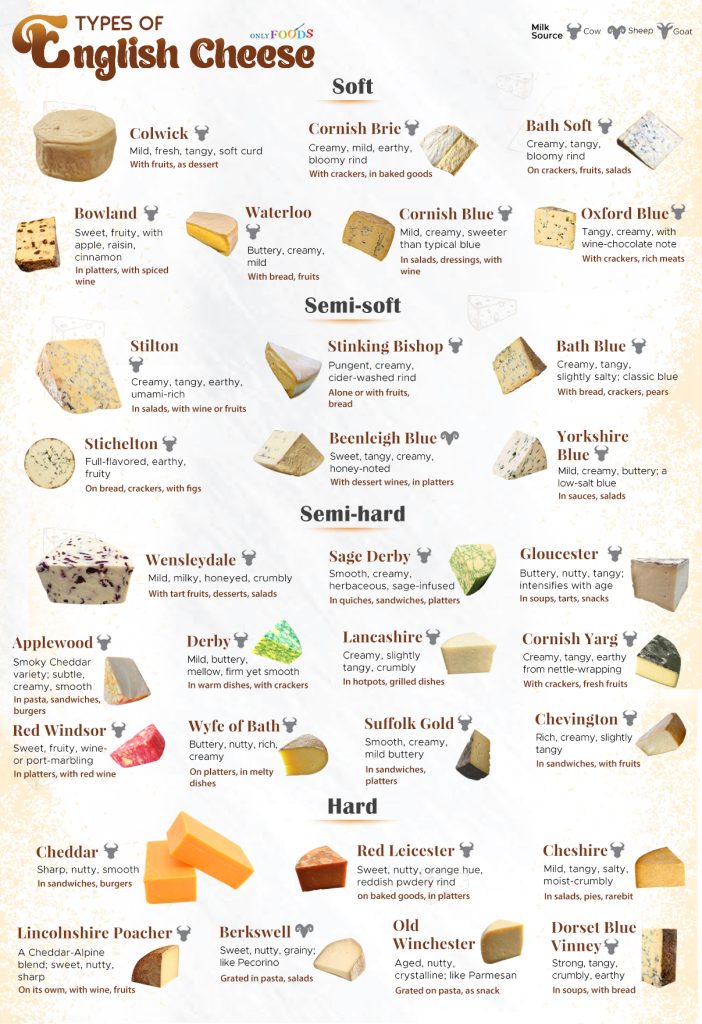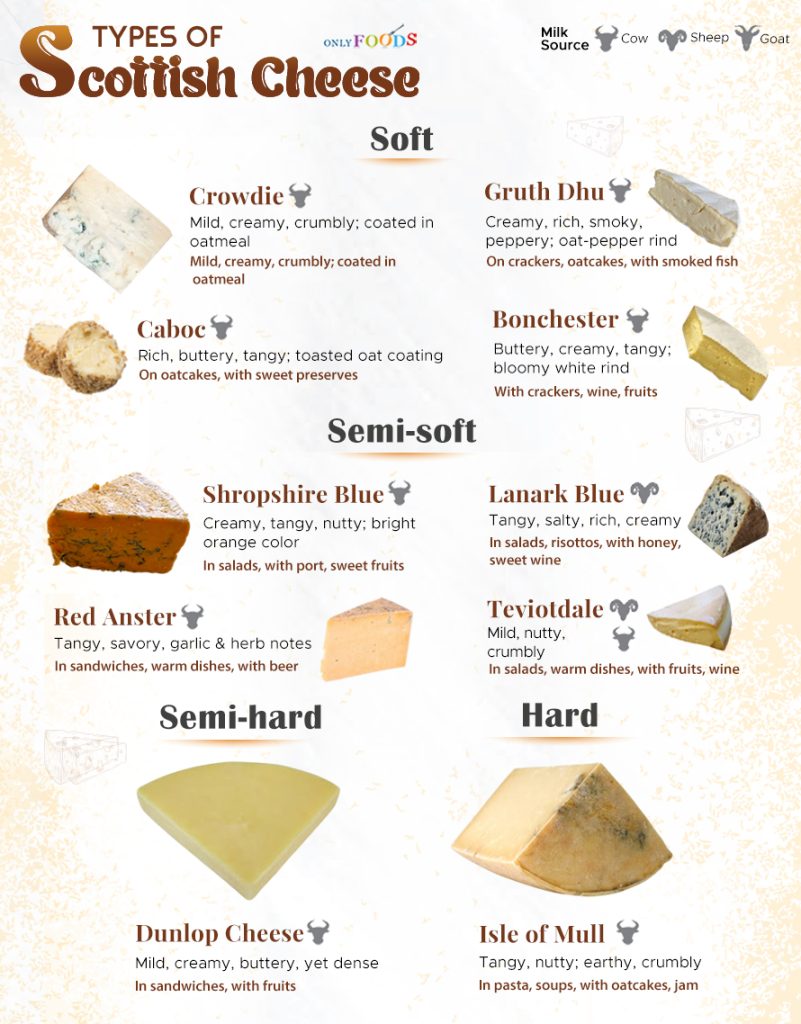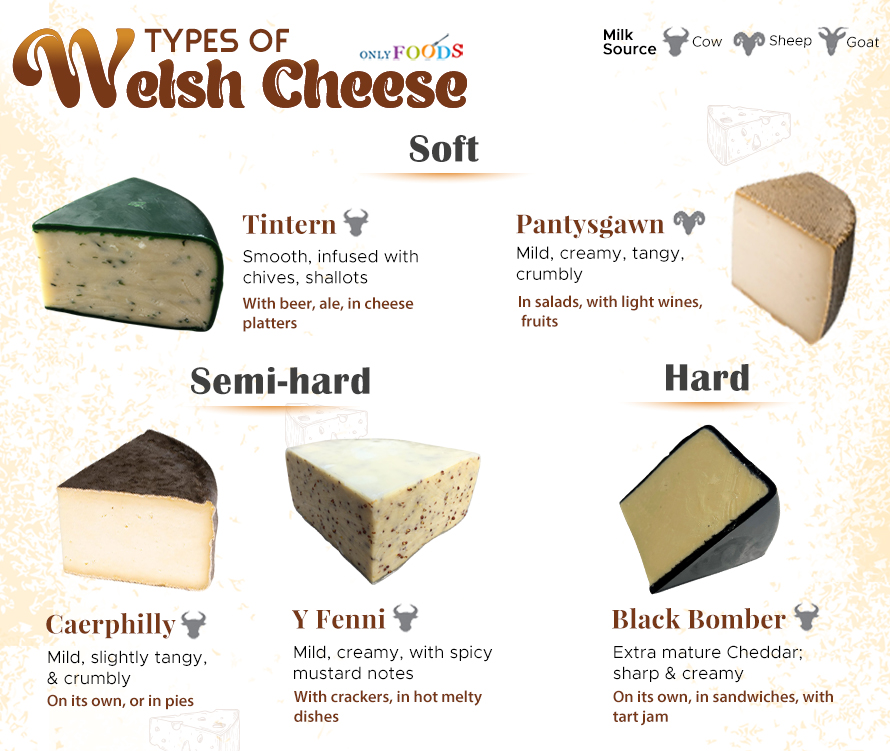Types of English Cheese & Other British Varieties
The United Kingdom’s rich cheesemaking tradition spans centuries, firmly establishing it as a cornerstone of the global cheese landscape. Cheddar, Stilton, and Cheshire are some of the best-loved cheese varieties all over the world, but the country offers so much more, with regional specialties like Red Leicester, Double Gloucester, and Cornish Yarg reflecting the unique geography and climate of their origins.
The different regions within Great Britain offer their unique styles in cheesemaking, which results in a wide range of varieties, including farmhouse and artisanal cheeses. While large commercial producers continue to provide popular favorites, many small-scale cheesemakers are reviving traditional methods and trying out new flavors.
Many British cheeses carry the prestigious Protected Designation of Origin (PDO) or Protected Geographical Indication (PGI) status, underscoring their authenticity and deep-rooted connection to British soil.
Types of Cheeses From England
England is renowned for its distinctive cheesemaking styles and is the birthplace of around a thousand varieties, including iconic names like Cheddar (PDO, PGI) and Stilton (PDO). Most English cheeses make use of cow’s milk, with only a few exceptions.
Here are the most famous English cheeses with their typical characteristics:
| Name | Popular | Flavor & Characteristics | Uses & Pairing Ideas | |||
|---|---|---|---|---|---|---|
| Cheddar | Hard | Cow | Somerset | Popular | Sharp and nutty with a smooth texture; mild to tangy based on age | In sandwiches, burgers, or paired with fruits and jams. |
| Stilton (Blue cheese) | Semi-soft | Cow | Leicestershire, Derbyshire, Nottinghamshire | Popular | Creamy, tangy, and earthy with rich umami notes | Crumbled on salads, paired with port wine or fruits, like pears |
| Wensleydale | Semi-hard | Cow | North Yorkshire | Popular | Mild, milky, slightly honeyed flavor with a crumbly texture | Paired with tart fruits like cranberries, added to desserts, or crumbled in salads |
| Red Leicester | Hard | Cow | Leicestershire | Popular | Rich, sweet, and nutty with an orange hue from annatto and a reddish powdery rind | Grated over baked dishes, included in cheese platters |
| Sage Derby | Semi-hard | Cow | Derbyshire | Popular | Smooth creamy, with a greenish hue and herbaceous undertones from sage infusion | Featured in cheese boards, adds a twist to quiches and sandwiches |
| Stinking Bishop | Semi-soft | Cow | Gloucestershire | Popular | Pungent with a creamy, almost meaty flavor and pear cider-washed rind | A standalone delicacy or paired with fruits, crusty bread |
| Cheshire | Hard | Cow | Cheshire | Popular | Mild yet tangy and salty with a crumbly but moist texture | In salads, pies, and regional dishes like Cheshire Rarebit |
| Gloucester (Single and Double) | Semi-hard | Cow | Gloucestershire | Popular | Buttery, nutty, and slightly tangy; flavor becomes stronger with aging | Used in soups and tarts and served as a snacking cheese |
| Applewood | Semi-hard | Cow | Somerset | Popular | Smoke-flavored variety of Cheddar with subtle flavors and a creamy, smooth texture | Perfect for melting in pasta, sandwiches, or burgers |
| Derby | Semi-hard | Cow | Derbyshire | Popular | Mild, buttery, and mellow with a firm yet smooth texture | Melts well in cooking, enjoyed on crackers |
| Lancashire | Semi-hard | Cow | Lancashire | Popular | Creamy and slightly tangy, easy to crumble | Ideal for cooking or grilling, often used in traditional Lancashire Hotpot |
| Cornish Yarg | Semi-hard | Cow | Cornwall | Popular | Creamy with a subtle tang and earthy notes from being wrapped in nettle leaves | Often served with crackers and fresh fruits |
| Red Windsor | Semi-hard | Cow | England | Popular | Sweet and fruity with reddish marbling from wine, port, or brandy | Used in festive platters, pairs well with red wines |
| Stichelton (Blue cheese) | Semi-soft | Cow | Nottinghamshire | Popular | Full-flavored with earthy and fruity notes | Often crumbled on crusty breads, crackers or paired with fruits like figs and pears |
| Lincolnshire Poacher | Hard | Cow | Lincolnshire | Popular | Sweet and nutty with sharp, tangy notes; a blend of Cheddar and Alpine styles | Enjoyed on its own or with wines, fruits, or jams, a good substitute for Parmesan |
| Berkswell | Hard | Sheep | West Midlands | Popular | Sweet, nutty flavor with a grainy texture, similar to Pecorino | Used for grating in pasta or salads |
| Colwick | Soft | Cow | Nottinghamshire | Popular | Mild, fresh, and slightly tangy with a soft curd texture | Paired with fresh fruits or used as a dessert cheese |
| Cornish Brie | Soft | Cow | Cornwall | Popular | Creamy, rich with a mild earthy flavor and edible bloomy rind | Served with crackers or in baked dishes |
| Bath Soft | Soft | Cow | Somerset | Popular | Creamy, rich, and slightly tangy with a bloomy rind | Perfect for crackers, fruits, or fresh salads |
| Old Winchester | Hard | Cow | Wiltshire | Popular | Aged, nutty, with a crystalline texture similar to Parmesan | Grated over pasta, salads, or served as a snack cheese |
| Bowland | Soft | Cow | Lancashire | Popular | Sweet, and fruity with added apples, raisins, and cinnamon | Best for cheese platters or paired with spiced wines |
| Waterloo | Soft | Cow | Berkshire | Popular | Buttery, creamy, and mild | Ideal with crusty bread or fruits |
| Cornish Blue | Soft | Cow | Cornwall | Popular | Mild, creamy, and slightly sweet, less tangy than typical blue | Served in salads, dressings, or alongside wine |
| Wyfe of Bath | Semi-hard | Cow | Somerset | Popular | Buttery and slightly nutty with a rich, creamy texture | Served on cheese boards or melted into dishes |
| Oxford Blue | Soft | Cow | Oxfordshire | Popular | Tangy and creamy with spicy yet delicate wine and chocolate notes | Paired with crackers or rich meats |
| Suffolk Gold | Semi-hard | Cow | Suffolk | Popular | Smooth, creamy, with a mild buttery flavor | Great for sandwiches, melting, or cheese boards |
| Bath Blue | Semi-soft | Cow | Somerset | Popular | Creamy, tangy, and slightly salty, a typical blue cheese | Served with dark bread, crackers, or pears |
| Fine Fettle Yorkshire | Soft | Sheep | Yorkshire | Popular | Crumbly, fresh, and slightly salty: a British take on feta | Perfect for salads, Mediterranean dishes, or as a topping |
| Beenleigh Blue | Semi-soft | Sheep | Devon | Popular | Sweet, tangy, and creamy with notes of honey | Paired with dessert wines or added to cheeseboards |
| Chevington | Semi-hard | Cow | Northumberland | Popular | Rich and creamy with a slight tang | Best in sandwiches, grilled, or served with fruits |
| Swaledale | Semi-hard | Cow/ Sheep/ Goat | Yorkshire | Popular | Mild, creamy, and slightly tangy with a crumbly texture | Used in salads or eaten on its own with crackers |
| Hereford Hop | Semi-hard | Cow | Herefordshire | Popular | Mild, creamy, with a unique hoppy flavor from a coating of hops | Perfect for beer pairings or as a snacking cheese |
| Yorkshire Blue | Semi-soft | Cow | Yorkshire | Popular | Mild, creamy, and buttery; less salty than typical blue cheeses | Used in sauces, salads, or served with honey and walnuts |
| Cotswold | Semi-hard | Cow | Gloucestershire | Popular | Buttery with notes of onion and chives | Featured in cheese boards or melted in savory dishes |
| Blacksticks Blue | Soft | Cow | Lancashire | Popular | Tangy, creamy, and slightly sweet | Spread on bread, crackers, paired with fruits, and in cooking |
| Huntsman | Semi-hard | Cow | Gloucestershire | Popular | Layers of buttery Double Gloucester with tangy Stilton | Served as a centerpiece on cheeseboards |
| Winslade | Soft | Cow | Hampshire | Popular | Creamy and rich with pine notes (from the spruce bark that wraps the cheese) | Best enjoyed with crackers or baked |
| Dorset Blue Vinney | Hard | Cow | Dorset | Popular | Strong, tangy, and crumbly with earthy notes | Used in soups or served with crusty bread |
| Dorstone | Soft | Goat | Herefordshire | Popular | Bright, citrusy, and fluffy witha distinct turret shape and ashed rind | Paired with fruits or artisan bread |
| Tunworth | Soft | Cow | Hampshire | Popular | Camembert-style, earthy, and mushroomy with a rich, creamy interior | Paired with crusty bread or roasted vegetables |
| Golden Cross | Soft | |||||
| Birdwood Blue Heaven | Soft | |||||
| Allerdale | Semi-hard | |||||
| Ashdown Foresters | Hard | |||||
| Raven’s Oak | Soft | |||||
| Exmoor Blue | Semi-soft | |||||
| Dorset Drum | Hard | |||||
| Farleigh Wallop | Semi-soft | |||||
| Blue Wensleydale | Semi-hard | |||||
| Buxton Blue | Semi-soft | |||||
| Harbourne Blue | Semi-soft | |||||
| Suffolk Bang (no longer produced) | Semi-hard | |||||
| Wiltshire Loaf | Semi-hard | |||||
| Blue Monday | Soft | |||||
| Gevrik | Soft | |||||
| Norbury Blue | Soft | |||||
| Baron Bigod | Soft | |||||
| Keltic Gold | Semi-hard | |||||
| Tesyn | Soft | |||||
| Harlech | Semi-hard | |||||
| Sussex Slipcote | Soft | |||||
| Isle of Wight Blue | Soft | |||||
| Dovedale Blue | Soft | |||||
| Little Wallop | Soft | |||||
| Cotherstone | Semi-hard | |||||
| Merry Wyfe | Semi-soft | |||||
| Goosnargh Gold | Semi-hard | |||||
| Croglin | Semi-soft | |||||
| Brighton Blue | Semi-soft | |||||
| Parlick Fell | Semi-soft | |||||
| Lymeswold (no longer produced) | Soft | |||||
| Duddleswell | Hard | |||||
| Blissful Blue Buffalo | Semi-soft | |||||
| Renegade Monk | Soft | |||||
| Oxford Isis | Soft | |||||
| Little Derby | Semi-hard | |||||
| Black Eyed Susan | Semi-soft | |||||
| Devon Blue | Semi-soft | |||||
| Brinkburn | Semi-hard | |||||
| Coquetdale | Semi-hard | |||||
| Village Green | Hard | |||||
| Coverdale | Hard |
Types of Cheeses From Scotland
Scotland’s rich cheesemaking tradition traces its roots back to the Viking Age. Among its earliest creations is Caboc, said to have originated from a Viking princess who passed her cherished recipe to her daughter—a practice that continues to this day, with the recipe safeguarded through generations.
Much like in England, most Scottish cheeses are crafted from cow’s milk. However, notable exceptions such as Lanark Blue and Teviotdale showcase the unique character of sheep’s milk. Some of these cheeses have earned protected status to ensure their authenticity and heritage remain intact. For instance, Bonchester enjoys PDO designation, while others, like Dunlop and Teviotdale, have PGI recognition.
Here is a list of all the famous Scottish varieties:
| Name | Flavor & Characteristics | Uses & Pairings | |||
|---|---|---|---|---|---|
| Shropshire Blue | Semi-soft | Cow | Inverness | Creamy, tangy with a sharp, nutty undertone and a bright orange color | In salads, cheese boards, or paired with port wine or sweet fruits |
| Isle of Mull | Hard | Cow | Isle of Mull | Strong, tangy, nutty flavor with earthy notes and a crumbly texture | Often grated over pasta, added to soups, or enjoyed with oatcakes and jams |
| Crowdie | Soft | Cow | Scotland | Mild, creamy, crumbly, slightly tangy, and coated with oatmeal; traditionally hand-rolled | Spread on bread or oatcakes, paired with smoked salmon or honey |
| Dunlop Cheese | Semi-hard | Cow | Ayrshire | Mild, creamy, and buttery with a smooth, dense texture (like a soft Cheddar) | Creamy tangy with a sharp, nutty undertone and a bright orange color |
| Gruth Dhu | Soft | Cow | Scotland | Creamy and rich with a distinct smoky and peppery flavor, coated in black pepper and oatmeal | Spread on crackers and oatcakes or paired with smoked fish or savory preserves |
| Caboc | Soft | Cow | Scotland | Rich, buttery, and slightly tangy, coated in toasted oatmeal | Spread on oatcakes and toast or paired with sweet preserves |
| Lanark Blue | Semi-soft | Sheep | Lanarkshire | Tangy, salty, and rich with a creamy texture | In salads, risottos, or cheese boards or with honey and sweet wines |
| Red Anster | Semi-soft | Cow | Fife | Tangy, savory flavor with a hint of garlic and herbs | In sandwiches or other warm dishes or served with beer |
| Bonchester | Soft | Cow | Roxburghshire | Buttery, creamy flavor with a slightly tangy finish and bloomy white rind. | Enjoyed on its own, with crackers, or paired with light wines or fruit |
| Teviotdale | Semi-soft | Sheep, Cow | Teviotdale | Mild, nutty with a crumbly texture | Melted over dishes, added to salads, or paired with fruits and wines |
Types of Cheeses From Wales
Though not as varied, Wales has made a notable contribution to British cheesemaking. All Welsh cheeses are crafted from cow’s milk, with one delightful exception: the goat cheese, Pantysgawn. Here are the most notable Welsh cheeses:
| Name | Flavor & Characteristics | Uses & Pairings | |||
|---|---|---|---|---|---|
| Caerphilly | Semi-hard | Cow | Mid Glamorgan | Mild, slightly tangy with a crumbly texture | Great in pies or eaten on its own |
| Black Bomber | Hard | Cow | Snowdonia | Extra mature Cheddar with intense sharpness and creamy texture | On its own, in sandwiches, or with tart jam or chutney |
| Y Fenni | Semi-hard | Cow | Monmouthshire | Mild, creamy, infused with mustard seeds and ale, giving a spicy kick | Perfect with crackers or melted into dishes |
| Tintern | Soft | Cow | Monmouthshire | Infused with chives and shallots, with a smooth texture and green wax coating | Served with beer or ale and in cheese boards |
| Pantysgawn | Soft | Goat | Blaenavon | Mild, creamy, and slightly tangy, with a crumbly texture | In salads, spreads, or with light wines and fresh fruits |
Britain’s passion for cheese has inspired one of its most peculiar and celebrated traditions: the Cooper’s Hill Cheese-Rolling and Wake. Held annually in the village of Brockworth, Gloucestershire, this quirky event sees participants hurtling down a steep 90-meter hill in pursuit of a wheel of Double Gloucester cheese. Its international popularity, attracting enthusiasts from across the globe, reflects not only the world’s appreciation for British cheeses but also the enduring charm of its age-old customs.



